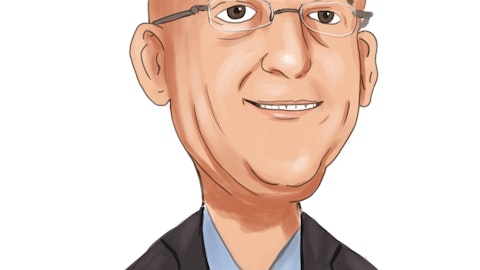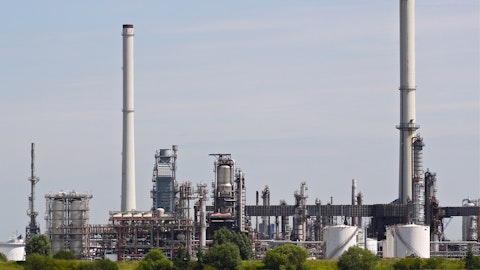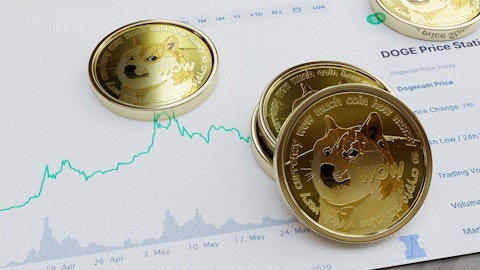Harsha Agadi: And I think, Don, Ryan and team have already started, if you will, on the path of subscription service on JP3. So over time, you’re going to see more subscription revenue format coming into JP3 that has not happened before. So this has already begun and the traction is pretty good. And in addition, also the reengineering efforts that Ryan has conducted will lower our entry point for our customers in a very effective way.
Don Crist: I appreciate that. One final one for me for Bond. The G&A efforts that you’ve made so far in your short two months that you’ve been there or three months that you’ve been there is truly commendable. When do you think you get to that kind of 10% of revenue? Is that like third quarter or fourth quarter or before that?
Bond Clement: Yes. Don, I think we’re going to get there probably sometime around the third quarter in terms of the revenue growth hitting the 30 frac fleets obviously sometime around midyear is going to be a big driver of that percentage, but certainly fourth quarter for sure, possibly third quarter.
Don Crist: I appreciate all the comments and truly commendable what you’ve done over the past few months. I’m excited to see what happens going forward. Thank you.
Harsha Agadi: Thank you, Don.
Operator: The next question comes from Jeff Robertson of Water Tower Research. Please go ahead.
Jeff Robertson: Thank you. Good morning. Ryan, if Flotek moves some of their frac fleets to oil basins from gas, does that have much of an impact on the type of margin for the chemical suite that you provide crews working in those types of formations?
Ryan Ezell: That’s a great question, because we’ve been tracking very closely the impact of movements from the gas basis to the oil basins. I think we do see a slight shift in product mix, but I wouldn’t say there’s a massive change in the profitability, but there is some revenue differential. We run a little bit if you take say for the instance the Haynesville, because we run some hybrid type systems. Typically, the average revenue per fleet is a little higher in East Texas than it is in West Texas just because of the basic — more basic slickwater system we see out in West Texas. So it’s more about the revenue and not as much as it would impact the margin per se.
Jeff Robertson: On the — I think you mentioned trucking costs and eliminated your dedicated trucking contracts. Is there anything you all can do to leverage with ProFrac or trucking needs to maybe — so both of you could negotiate savings?
Ryan Ezell: You know, that’s a — from our standpoint, that’s exactly what these amendments that we did to the contract has held was due. So we’ve been tracking we brought on a system that was similar to what ProFrac runs in terms of digitized trucking for how they move their sand and a lot of logistical movements that they do. This helped us validate where we were on our dedicated truck fleet utilization, which led to us terminating some of those contracts are going to a expanded vendor base, but on a callout basis, on a digitized trucking route optimization, we’ve also begin to coordinate as we’ve now stood up to a substantial number of fleets on how we do pad-to-pad movements as some of the in-basin transfers. And then also our ability to generate services and service revenue for doing that.
So I would say we kind of hit it on all three for us in terms of operational efficiency on an optimization point, synergistically working with ProFrac for pad-to-pad movements and then our ability to transfer and gain service revenue for some of these particular movements that we do now. And so we hit it on all three fronts from that point.
Jeff Robertson: So that integration hopefully saves some costs for Flotek, but it also just increases the coordination and how you’re servicing their crews to make their crews more efficient and hopefully more efficient for the E&P customer as well?
Ryan Ezell: Absolutely. And we’ve gone even further now that we’ve got a really good solid three quarters under the belt we’ve started looking at other ways that we can improve our service through how we move the chemistries, the types of chemistry packages, stay stays monitoring and really driving what we look at is the combined value propositions of reduced emissions and efficient chemistry utilization.
Jeff Robertson: Bond, you mentioned in your presentation you note that you all are looking at ABL facility for liquidity? Can you talk about any scale or magnitude of facility you’re looking for? And with will that plus the expected cost savings, which should convert into EBITDA, will that be enough to satisfy the going concern language in your audit?
Bond Clement: I’ll take the second part first. Yes, we’re able to get an ABL certainly as it relates to alleviate the going concern that our auditors feel that they needed to disclose. I think that it would satisfy that. I don’t want to get into the details, Jeff, of the discussions that we’re having just because we are, sort of, in the heat of looking at diligence items and expecting some term sheets, I prefer to stay away from what our expectations are regarding the terms.
Jeff Robertson: Okay. And just real quick on the material weakness, you said you all have steps in place to cure that, so that should go away relatively in the near-term?
Bond Clement: Yes, we think we’re going to be able remediate that very quickly. I mean, effectively, we tripled the workload of the back office staff. We had some communication breakdowns and so we’re going to augment some of the staff and implement some procedures where people are talking to each other.
Jeff Robertson: Okay. Thank you very much.





